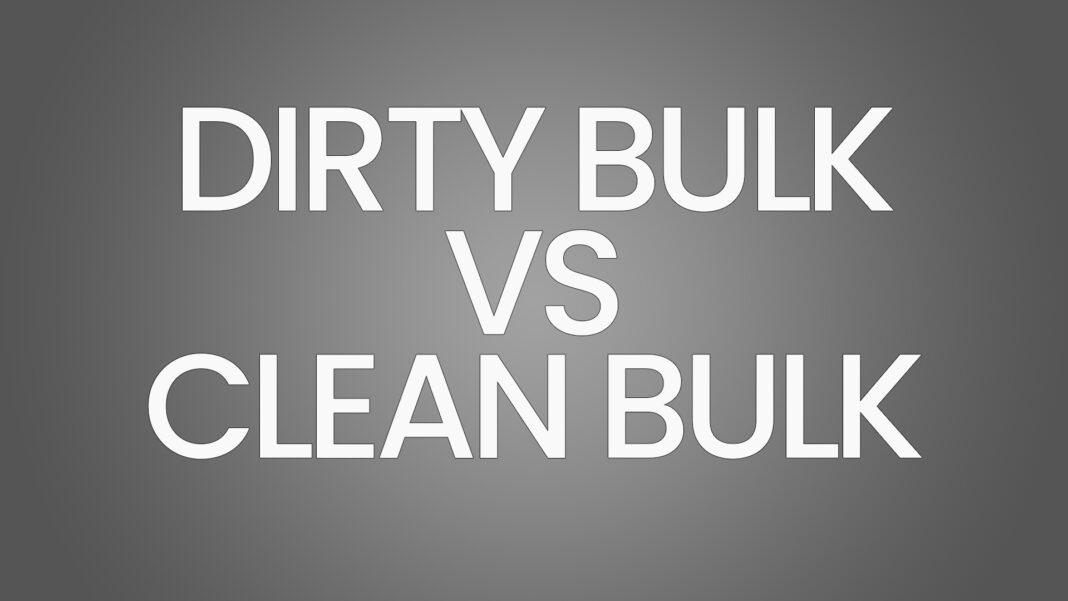Though weight loss is the more commonly seen goal among exercisers, there are plenty who wish to increase the size and strength of their musculature, as well as gain weight.
This is made possible through proper training, rest, and the right dieting strategy – in this case being that of the bulking diet.
As can be clued in by its name, a bulking diet is a diet where the exerciser will eat sufficient amounts of food to allow their body to grow at an accelerated pace.
This is often split into two types of dieting; dirty and clean – of which is differentiated by the amount of additional calories eaten during the diet.
It should be noted, the “types” of food have nothing to do with how clean a bulk is.
What is Bulking?
To put it in more technical terms, a bulking phase diet or simply “bulking” is a nutritional tactic used by exercisers where they place their body in a state of caloric surplus by eating additional food, thereby providing enough nutrients and energy to develop their musculature in a reliable manner.

At the higher levels of training, being in a caloric surplus is essential for proper muscular development, and is otherwise impossible without the presence of this additional energy.
It should be noted that – regardless of whether the bulk is clean or dirty – bulking will almost always result in an increase of body fat alongside lean muscle mass, of which is simply an unfortunate consequence of human physiology.
Why Do Gym-goers Bulk?
Gymgoers and other types of individuals undergoing physical training will undergo a bulking diet in order to accelerate or enable their continued muscular growth.
This is primarily because the body requires additional nutritional materials and energy in order to build new muscle fibers, but is also important due to the factor of greater energy requirements as the exerciser ramps up their training as well.
Basic Principles of Bulking
Simply eating a caloric surplus is not enough to constitute a proper bulking diet, and there are several principles one must stick to when choosing to undergo this particular dieting strategy – regardless of whether they are using a dirty or clean bulking diet.
The first is that the exerciser must ensure the food they are eating, and the caloric surplus they are producing are both sustainable over the long term. Consuming food with a lack of certain vitamins or minerals can quickly lead to malnutrition, even if they are eating plenty of it.
Furthermore, the exerciser should also consume enough protein to fuel their muscular development; This is of particular importance, and we will expand on it further.
Finally, there is also the matter of matching up the exerciser’s training intensity with the caloric surplus of their bulk.
Insufficient training stimulus or the wrong type of exercise can lead to excessive weight gain and stunted muscle growth, whereas excessive training intensity can cause the caloric surplus to be expended due to the exercise itself.
The Importance of Protein

Protein is a macronutrient of essential importance to the very concept of muscular development, as it provides amino acids that act as building blocks for the creation of muscle cells.
While there is some debate as to how much protein is required for optimal muscular hypertrophy, it is nonetheless quite important that all exercisers performing a bulk ensure that they are intaking at least 0.6 grams of protein per pound of bodyweight, which is widely considered to be the absolute minimum.
Intaking complete proteins is also important in this aspect, as proteins with incomplete amino acid profiles are less effective at aiding in recovery and muscular development.
What is Dirty Bulking?
Dirty bulking is essentially the sprint of bulking diets, wherein exercisers will consume as much food as possible (while also controlling for protein intake), thereby maximizing any potential muscular gain that they may have accrued from their training.
Unfortunately, due to this large intake of food, it is also likely that the exerciser will gain far more fat from their diet than they may wish to have.
This can cause a longer cutting phase once the dirty bulk is complete, or otherwise lead to health issues in certain cases.
Dirty bulking is most often performed by high level athletes under the supervision of specialized coaches, by novices taking advantage of the “newbie gains” phenomenon, or by individuals who are underweight and wish to gain weight as quickly as possible.
Advantages of Dirty Bulking
The main advantage of dirty bulking is that it maximizes any possible development that the exerciser may have, both speeding up the rate at which muscular protein synthesis is achieved, and maximizing it so as to get every gram of muscle fiber possible from such a response.
On top of this, there is also the matter of convenience.
Dirty bulking does not require the exerciser to count their calories, and as such will generally allow for the intake of calorically dense foods that can make achieving a caloric surplus all the more easy.
Furthermore, dirty bulking is one of the few assured ways of inducing weight gain, regardless of whether it is fat or muscular tissue. So long as it is being done correctly, there is no doubt that a healthy individual will gain weight when undergoing a dirty bulk diet.
This is not as much the case in clean bulking or other forms of weight gain diets, as a variety of factors may make the comparatively small caloric surplus of such diets ineffective due to expenditure.
Disadvantages of Dirty Bulking
The clearest disadvantage of the dirty bulk is that it creates more fat tissue than other mass-gaining diets.
While a minimum of body fat is essential for proper health, excessive amounts of adipose tissue can lead to serious health consequences – and require a greater length of time to remove, if that is the goal of the exerciser.
Dirty bulking is also usually less healthy due to its inclusion of processed foods or other kinds of food products that do not necessarily have the highest nutritional quality, with the majority of dirty bulk participants choosing cheap and calorically dense food due to its convenience, rather than its healthiness.
What is Clean Bulking?
Clean bulking is the slower but healthier cousin of dirty bulking, with its key features being close and careful tracking of caloric intake, macronutrient partitioning and maintaining as minimal a caloric surplus as possible so as to avoid excessive fat development.
Clean bulking diets are preferred by many higher level exercisers due to the fact that it allows them to retain their body fat percentage and health while still giving the body sufficient material with which to develop muscle mass.
Certain versions of a clean bulk diet even go a step further, removing processed foods or other types of food products seen as unhealthy – with the practitioner choosing to solely eat organic or locally-sourced foods instead.
While this variation of the clean bulk is indeed healthier, it is also more difficult and does not directly affect muscular development, for the most part.
Advantages of Clean Bulking
The main advantage of performing a clean bulk is in its efficiency, producing no extra fat stores that may need to be burned at a later time.
The intention of a clean bulk is to provide the body with just enough additional nutrients to enable muscle protein synthesis, and as such another advantage of clean bulking is in its cost-effectiveness and time-saving aspects.
When doing a clean bulk, it is likely that the exerciser will not need to deviate from their normal eating routine in terms of volume or number of meals per day – allowing them to save time and money that may otherwise be consumed if performing a dirty bulk.
Disadvantages of Clean Bulking
Despite how healthy and efficient clean bulking can be, there are also several disadvantages relating to the time and effort needed in planning for it.
The exerciser will need to pay close attention to the macronutrients and caloric value of every meal, painstakingly tracking them and ensuring that they do not eat too great of a caloric surplus.
In addition, the ever-changing nature of athletic training and daily activities means that the exerciser will also need to adjust their caloric surplus as needed, lowering or increasing it depending on their caloric expenditure throughout the day.
Furthermore, certain studies point towards clean bulking being somewhat less effective at packing on muscle mass than dirty bulking – though many studies also contradict this idea, stating that both clean and dirty bulking produce essentially the same amount of muscle mass.
In the end, this particular disadvantage appears to be more of a case-by-case issue rather than one relating to clean bulking itself.
In theory, if performed correctly, there is no difference in muscle protein synthesis between clean and dirty bulking.
Dirty Bulk vs Clean Bulk for Muscle Growth
In terms of muscle growth, the difference between the dirty bulk and the clean bulk is more about convenience and effort rather than actual muscle protein synthesis.
Generally, individuals will not need to put as much thought and effort into gaining muscle while on a dirty bulk, as it will essentially provide everything the body needs to create muscle mass by the very nature of eating large amounts of food.
This is not so much the case in clean bulking, which will require careful tracking and adjustment of the exerciser’s food intake, with a particular focus on the caloric value of such foods.
While too many calories will lead to unwanted fat gain, too little may deprive the muscles of much-needed nutrients, stunting the exerciser’s muscular growth.
As such, it is the dirty bulk that is better for muscle growth, simply due to the simplicity with which it allows this to happen.
In actuality, both the clean bulk and the dirty bulk produce equal amounts of muscle protein synthesis – so long as they are done correctly.
Health Differences of the Dirty Bulk and Clean Bulk
Without question, clean bulking is far healthier than dirty bulking.
While the amount of muscle mass developed from both diets is nearly the same, the fat development is not. Dirty bulking will quickly lead to high levels of body fat if sustained for long periods of time, especially if the exerciser is intentionally eating as many calorie-dense foods as possible.
Having high levels of body fat, or otherwise developing excessive amounts of fat in a short time, are both linked to a number of health issues that can negatively impact the quality of life and lifespan of the exerciser.
Furthermore, many individuals performing a dirty bulk will “cheat” by eating highly processed foods so as to pad out their caloric intake, usually taking the form of sugary drinks or food products loaded with processed oils.
While these food products are indeed excellent in terms of high caloric value, they are generally not nutritious, and solely relying on such kinds of food can lead to malnutrition.
In short – for health, it is the clean bulk that is vastly superior.
Fat Gain of Dirty Bulk and Clean Bulk
Once again, the clean bulk is the superior diet if minimal fat gain is your goal.
The entire purpose of performing a clean bulk is to minimize fat gain while maximizing muscular development, immediately making the clean bulk superior to the dirty bulk in such matters.
However, if you wish to gain large amounts of fat for whatever reason, the dirty bulk is the better choice.
It is so effective at increasing body weight in fact, that sumo wrestlers or other participants of sports that require heavy body weight will do dirty bulk diets during their pre-season training phases, rapidly increasing their fat and muscle mass.

